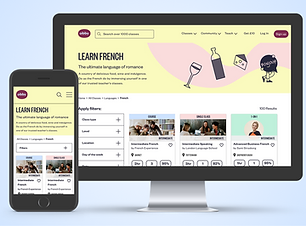Team Up
Building a platform for shared experiences

Overview
Shared experiences can be more enjoyable experiences. This concept project presented a unique opportunity to build a safe, fun way to connect people who want to attend concerts and events with others.
The goal of this project was to leverage Ticketmaster's legacy brand and trustworthiness to conceptualize and build a new social element called Team Up.
Concept Project
Role & Duration
Competitive Analysis, User Flows, Wireframes (Low and Mid Fidelity), Usability Testing, High Fidelity Mockup (checkout process)
Team: 4 designers
Timeline: 2 weeks
The Problem
For a legacy brand like Ticketmaster, it's important to explore and develop new ways to engage audiences with a potential area of opportunity in building social features. Creating a social network for individuals or groups that want to meet up and go to events presents a unique chance to appeal to their user base in a different way.
But, what about concerns surrounding safety when meeting in real life - how do you make going to concerts feel as safe as meeting for an afternoon coffee? More importantly, is there an appetite for a social network built around shared experiences?
What does the journey of collaborative decision-making and event attendance look like?
User Research
We sent out a survey, conducted 11 interviews, and explored the competitive landscape. We focused on personal safety when meeting "in real life," would people be open to sharing concert experiences with online connections, and experiences surrounding concert-going.
-
How do people feel about meeting online connections and what do they do to ensure their personal safety
-
Is there a market need for connecting people with shared interests
-
What are some of the frustrations with coordinating groups and purchasing tickets
-
Would people be open to a group purchasing journey with someone they've never met

Fig 1. Affinity mapping interview and survey learnings
Qualitative & Quantitative Data
A survey and user interviews were quintessential in exploring the value proposition of a social network built on concert-going.
Would people feel safe and be open to that kind of experience? Why do people like attending concerts with others and what frustrates them when organizing a group experience?

SAFETY
“Nowadays, I would only meet up with an online connection if we had a mutual friend.”

APPEAL
“I’ve been alone to events before. It’s OK, but company is much preferred.”

PURCHASING
“I’ve bought tickets before without knowing exactly who I’m going with.”
39%
Of 28 survey respondents have met an online connection in real life and would do so again.
89%
Of 19 survey respondents expressed interest in meeting new people.
Competitive Analysis
Taking lead on the competitive analysis, I took a deep dive targeting some of Ticketmaster's direct and indirect competitors. I was curious to understand how they address personal safety and allow members to discover other people with similar interests.
Solutions exist for what happens before and after a purchasing journey. Splitwise addresses repayment after shared purchases, and Airbnb allows for group input and decision-making. But, a lone "group organizer" is left with full responsibility for payment at the time of purchase.
What opportunities are there for collaborative decision-making combined with individual purchasing responsibility?

Insights & Opportunities
After gathering insights from our research and market review, we identified opportunities and features in answer to our three themes of safety, meeting new people and collaborative purchasing.

Design Process
With a wealth of information and a lot of ideas, our team converged on a typical Team Up member and her problem to solve. With her in mind, we designed and tested a user journey exploring elements and features reinforcing themes of safety, trust, collaboration and group purchasing.
One of the biggest challenges in this project was creating a sense of trust and security in the journey - how to make people feel comfortable purchasing tickets with a connection they've only met online.
Our persona Josie wants to explore the local music scene and build up a network of like-minded music fans. Using a problem statement and scenario built around Josie, we narrowed our focus in ideation.
A team design studio helped us visualize Team Up's features and core parts of Josie's journey. Coming up with an initial concept to build into a paper prototype.
The first version of the user journey focused on group purchasing and collaboration all within the Team Up chat function. Testing revealed people felt insecure and uncomfortable with an in-chat purchasing process.
The second version of the user journey moved the payment journey out of the chat and into a traditional payment journey. A group coordinator completes all purchase selections with team members seeing chat updates in real time.
Participants expressed a lack of control in purchasing decisions and mistrusted a "coordinator" they just met online, leading us to our final user flow.
The Solution
A collaborative purchasing journey putting control in the hands of all group members, establishing trust and security amongst the community.
Invitation-only groups are created and collaborated on over time, with all decisions made and editable before purchasing. Once all team members are online and ready to purchase, Team Up is activated from the group event page.
Everyone purchases individually - no one is left footing the bill.
Project Learnings
You can be too creative sometimes.
People find comfort in familiarity. In our effort to design an end-to-end collaborative purchase using in-app messaging, we confused our users. People did not understand purchasing nested within a chat nor were they comfortable with the idea. Moving to a journey that separated event creation from payment felt more familiar and provided a greater sense of security.
It's ok to disagree - just back it up with research.
Clear, concise on boarding is vital in understanding the Team Up journey. I felt a splash screen at login would cause less friction in the journey. Another team member wanted to "slow reveal" on boarding throughout the journey. We went ahead with the "slow reveal" and testing found users uncertain how it worked at first or were annoyed with the messages when they did appear. If I had been more evidence- instead of opinion-based in my disagreement, we may have designed a less intrusive way to on board users.






